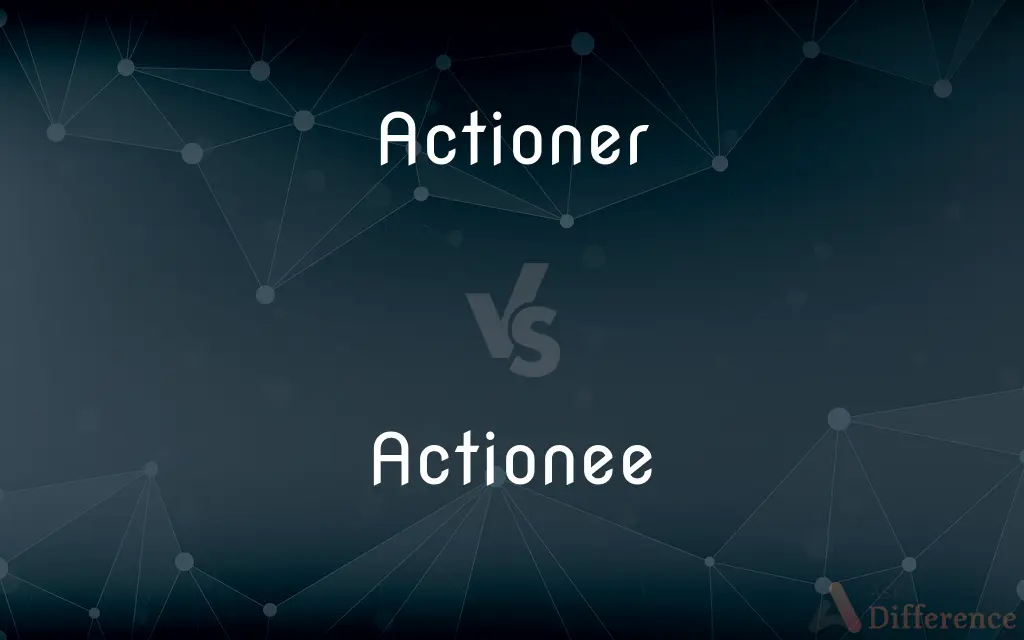Actioner vs. Actionee — What's the Difference?
By Fiza Rafique & Urooj Arif — Updated on March 22, 2024
An actioner initiates or performs an action, while an actionee is the recipient or the subject of that action.

Difference Between Actioner and Actionee
Table of Contents
ADVERTISEMENT
Key Differences
An actioner refers to a person or entity that initiates or performs a specific action, task, or duty. It highlights the role of being the active participant in a process. In contrast, an actionee is on the receiving end of an action or task, often being impacted or changed by the actioner's decisions or actions. This distinction emphasizes the dynamic between the initiator and the receiver in various contexts, from business to legal proceedings.
While the term actioner focuses on the doer or the one who carries out actions, the actionee is more passive, experiencing the effects or outcomes of those actions. This difference is crucial in settings where responsibilities and roles need to be clearly defined, such as project management or legal documentation, to ensure clarity in who is doing what and who is affected.
The actioner is often seen as the driving force behind changes or movements, taking steps towards achieving goals or completing tasks. Meanwhile, the actionee, although passive, plays a significant role in the process by being the one for whom the action is intended or upon whom the action has an effect. This relationship is vital in collaborative environments, where the interaction between actioner and actionee can lead to progress and innovation.
In terms of responsibility, the actioner bears the weight of ensuring that actions are carried out effectively and ethically, while the actionee may need to provide feedback or respond to the actions taken. This interplay is essential in adaptive systems where actions and reactions are continuously assessed for improvement.
Understanding the roles of actioner and actionee is key in any organized system or process, as it helps delineate duties and expectations, ensuring that all participants are aware of their roles and how they contribute to the overall objective. This clarity enhances communication, efficiency, and accountability in achieving desired outcomes.
ADVERTISEMENT
Comparison Chart
Role
Initiator or performer of an action
Recipient or subject of an action
Nature
Active, performing tasks
Passive, affected by tasks
Responsibility
Carries out actions, drives changes
Receives actions, influenced by changes
Impact
Affects others, environment, or processes
Affected by actions of others
Key in
Leadership, project management, decision-making
Feedback, adaptation, response to actions
Compare with Definitions
Actioner
An entity responsible for taking action in a given context.
The department was the actioner of the policy changes.
Actionee
The individual or group that a particular action is directed towards.
Employees were the actionees in the new training program.
Actioner
A person who initiates or executes a plan.
The project manager is the actioner for the new initiative.
Actionee
A passive participant in an action-oriented scenario.
The actionee of the policy change was the customer service department.
Actioner
The active force in a situation.
In the software development life cycle, the programmer acts as the actioner.
Actionee
The recipient of actions in a process.
In the workflow, the next actionee is the quality assurance team.
Actioner
A role in a process that involves initiating changes.
The committee chairperson is the main actioner for the reform.
Actionee
Someone impacted by decisions or actions of others.
The actionees of the software update were end-users.
Actioner
Someone who carries out specific tasks.
As an actioner, she finalized the report.
Actionee
The focus of an action or task.
The document was sent to the supervisor for review, making him the actionee.
Actioner
(informal) An action movie.
Actionee
(management) The recipient of an action item; the person assigned responsibility for a specific task or issue.
Common Curiosities
What responsibilities does an actionee have?
An actionee's responsibilities may include providing feedback, adapting to changes, and fulfilling requirements as affected by the action.
How does the role of an actioner differ in a team setting?
In a team setting, the actioner is often the leader or a member assigned specific tasks, driving progress towards goals.
How do actions impact the actionee?
Actions can impact the actionee in various ways, including changing their responsibilities, altering their status, or affecting their outcomes.
What are the characteristics of an effective actioner?
An effective actioner is proactive, responsible, and capable of driving actions towards achieving set objectives.
Can one be both an actioner and an actionee?
Yes, depending on the context and dynamics of a situation, one can be both the initiator and the recipient of actions.
Is the actioner always a person?
No, the actioner can also be an entity, such as a department or organization, taking action within a scenario.
Can the roles of actioner and actionee change over time?
Yes, roles can evolve based on the situation, with individuals or groups transitioning between being actioners and actionees.
What defines an actioner?
An actioner is defined as the person or entity that initiates or performs an action.
How does one become an actioner?
Becoming an actioner involves taking initiative, being assigned tasks, or assuming responsibilities that involve active participation.
Why is the distinction between actioner and actionee important?
This distinction clarifies roles and responsibilities, ensuring effective communication and accountability in processes.
Can the actionee influence the actioner?
Yes, the actionee can influence the actioner through feedback, collaboration, and shared goals.
Why is understanding these roles important in management?
Understanding these roles is crucial for effective management, as it helps in assigning tasks, defining responsibilities, and ensuring accountability.
In what scenarios is the actioner-actionee dynamic most evident?
This dynamic is most evident in structured environments like projects, workflows, and organizational processes.
Do actionees have any control over actions?
While actionees are primarily recipients, they may influence outcomes through feedback and reactions.
How do actioner and actionee roles contribute to project success?
They contribute by ensuring clear division of tasks and responsibilities, fostering cooperation, and facilitating goal achievement.
Share Your Discovery

Previous Comparison
Lounge vs. Lobby
Next Comparison
Career vs. ProfessionAuthor Spotlight
Written by
Fiza RafiqueFiza Rafique is a skilled content writer at AskDifference.com, where she meticulously refines and enhances written pieces. Drawing from her vast editorial expertise, Fiza ensures clarity, accuracy, and precision in every article. Passionate about language, she continually seeks to elevate the quality of content for readers worldwide.
Co-written by
Urooj ArifUrooj is a skilled content writer at Ask Difference, known for her exceptional ability to simplify complex topics into engaging and informative content. With a passion for research and a flair for clear, concise writing, she consistently delivers articles that resonate with our diverse audience.














































